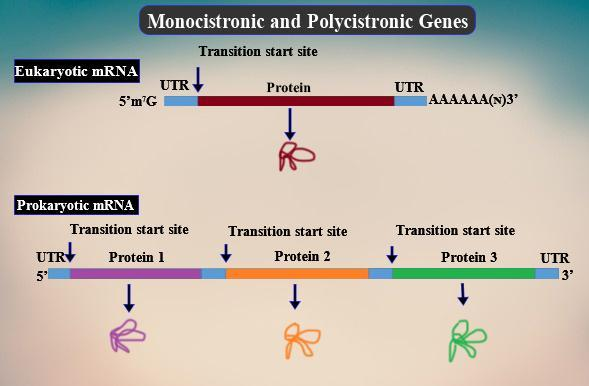
Answer
463.2k+ views
Hint: The segment of DNA that is equivalent to a gene specifies a single functional unit. Cistron is a segment of DNA that codes for one polypeptide.
Complete answer:
A Transcription unit refers to the sequence of nucleotides present in the DNA required for the formation of an RNA. It is monocistronic in eukaryotes and polycistronic in prokaryotes. It consists of a promoter region, structural gene, and a termination region. The monocistronic structural gene of the eukaryotes has interrupting coding sequences between them. The mature RNA or mRNA contains only exons and not introns (intervening sequences) . The process of removal of introns is known as ‘splicing’.

A gene can be monocistronic or polycistronic.
- Monocistronic mRNA is where only one gene is expressed from a promoter region. Each of them has its own promoter and terminator region.
- Polycistronic mRNA is the one that encodes several proteins. It is characteristic of many bacterial and chloroplast mRNAs. Polycistronic mRNAs consist of a leader sequence that precedes the first gene. Here many genes are present per promoter region.
So, the correct answer is ‘(c) Assertion is true, Reason is false'.
Note:
- The two strands of DNA in a structural gene possess opposite polarity. The strand having 3’ to 5’ polarity acts as the template strand and the other strand is known as a coding strand.
- The promoter is located ‘upstream' i.e. towards the 5’ end of the structural DNA. It provides the binding site for the RNA polymerase.
Complete answer:
A Transcription unit refers to the sequence of nucleotides present in the DNA required for the formation of an RNA. It is monocistronic in eukaryotes and polycistronic in prokaryotes. It consists of a promoter region, structural gene, and a termination region. The monocistronic structural gene of the eukaryotes has interrupting coding sequences between them. The mature RNA or mRNA contains only exons and not introns (intervening sequences) . The process of removal of introns is known as ‘splicing’.

A gene can be monocistronic or polycistronic.
- Monocistronic mRNA is where only one gene is expressed from a promoter region. Each of them has its own promoter and terminator region.
- Polycistronic mRNA is the one that encodes several proteins. It is characteristic of many bacterial and chloroplast mRNAs. Polycistronic mRNAs consist of a leader sequence that precedes the first gene. Here many genes are present per promoter region.
So, the correct answer is ‘(c) Assertion is true, Reason is false'.
Note:
- The two strands of DNA in a structural gene possess opposite polarity. The strand having 3’ to 5’ polarity acts as the template strand and the other strand is known as a coding strand.
- The promoter is located ‘upstream' i.e. towards the 5’ end of the structural DNA. It provides the binding site for the RNA polymerase.
Recently Updated Pages
Fill in the blanks with a suitable option She showed class 10 english CBSE

TISCO is located on the banks of which river A Tungabhadra class 10 social science CBSE

What is greed for clothes A Simply desire to have them class 10 social science CBSE

What does the 17th Parallel line separate A South and class 10 social science CBSE

The original home of the gypsies was A Egypt B Russia class 10 social science CBSE

The angle between the true north south line and the class 10 social science CBSE

Trending doubts
Fill the blanks with the suitable prepositions 1 The class 9 english CBSE

How do you graph the function fx 4x class 9 maths CBSE

Which are the Top 10 Largest Countries of the World?

Which is the longest day and shortest night in the class 11 sst CBSE

What is the definite integral of zero a constant b class 12 maths CBSE

Name five important trees found in the tropical evergreen class 10 social studies CBSE

The Equation xxx + 2 is Satisfied when x is Equal to Class 10 Maths

Differentiate between homogeneous and heterogeneous class 12 chemistry CBSE

Difference between Prokaryotic cell and Eukaryotic class 11 biology CBSE




